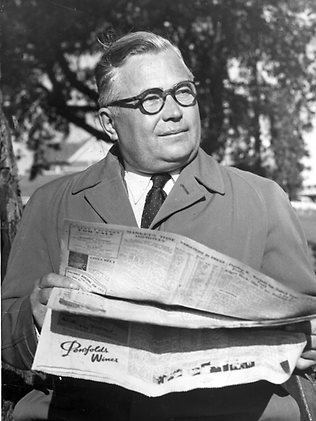Name Vladimir Petrov | Role Diplomat | |
 | ||
Died June 14, 1991, Bentleigh, Melbourne, Australia Similar Evdokia Petrova, Genrikh Yagoda, Nikolai Yezhov | ||
Vladimir Mikhaylovich Petrov (Russian: Влади́мир Миха́йлович Петро́в; 15 February 1915 – 14 June 1991) was a member of the Soviet Union's clandestine services who became famous in 1954 for his defection to Australia.
Contents
- Early life
- Intelligence career
- Joining OGPU
- Australia and defection
- Life after defection
- Fictional works
- References
Early life
He was born Afanasy Mikhaylovich Shorokhov (Russian: Афанасий Миха́йлович Шорохов), into a peasant family in the village of Larikha, in central Siberia.
He joined the Komsomol in 1923, using his Communist Party affiliation to gain an education, which would greatly benefit him. Through this education he was able to do well enough on his naval recruiting tests to become specially selected for the cipher-work training course. After the two-year technical course which qualified him as a cipher specialist, he was posted to a ship in the Baltic Sea to encrypt and decrypt the secret signals.
Intelligence career
According to his recently released secret British MI5 file, Petrov stated during his post-defection interviewing that his intelligence career was as follows:
Petrov also gave information about the defection of Burgess and Maclean of the Cambridge Five. Their escape had been handled by Kislitsyn, an M.G.B. officer who was in Australia when Petrov defected in 1954. Petrov also disclosed that Burgess and McLean were living in Kuibyshev in 1954. (National Archives Reference:kv/2/3440)
Joining OGPU
He decided to join the Soviet spy organization, the OGPU, in May 1933. He was subsequently admitted to the Special Cipher Section, which was attached to the Foreign Department of the OGPU. It was his status in this section which allowed him to learn many Soviet secrets by reading the top secret ciphers.
Petrov miraculously survived the purges of Stalin under Yagoda, Yezhov, and Beria. Even though a great number of his friends, colleagues, and superiors were arrested and executed, Petrov escaped unscathed.
Australia and defection
Having graduated from cipher clerk to full-fledged agent, Petrov was sent to Australia by the Russian Ministry of Internal Affairs (MVD) in 1951. His job there was to recruit spies and to keep watch on Soviet citizens, making sure that none of the Soviets abroad defected. Ironically, it was in Australia where the fateful events would occur, which led to his own defection from the USSR. This came about through his association with Polish-born doctor and musician Michael Bialoguski, who played along in seeming to allow Petrov to recruit him to gather information, while at the same time reporting to Australian Security Intelligence Organisation on Petrov's activities.
Vladimir Petrov applied for political asylum in 1954, on the grounds that he could provide information regarding a Soviet spy ring operating out of the Soviet Embassy in Australia. Petrov states in his memoirs (ghost written by Michael Thwaites) that his reasoning for defecting lay not in an imminent fear of being executed, but in his disillusionment with the Soviet system and his own experiences and knowledge of the terror and human suffering inflicted on the Soviet people by their government. He witnessed the destruction of the Siberian village in which he was born, caused by forced collectivization and the famine which resulted.
Life after defection
Petrov became an Australian citizen in 1956. His and his wife Evdokia's names were changed to Sven and Maria Anna Allyson. They lived a quiet suburban life in Melbourne. He died in 1991, and she died in 2002.
The whereabouts of the Petrovs were still the subject of a D-Notice in 1982.
Fictional works
Petrov's defection has inspired a number of fictional works.
